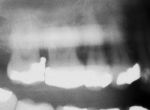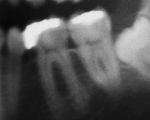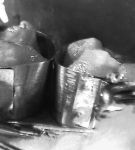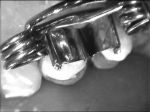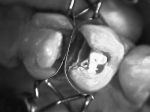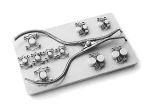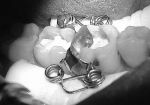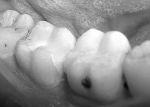The use of Walser matrices as a prophylactic measure for overhanging fillings
The latest conservative dentistry uses two and more-layer fillings as a preventive procedure. Shaping the filling and securing a full condensation of the material in 2nd degree cavities requires the use of matrices and their holders (tighteners). With the matrix, we are able to change an open edge cavity to an enclosed one. This enables an easier filling and creates a solid contact point with a perfect cervical filling enclosure. (1)
If the matrix does not fit a gingival area tightly, it is necessary to use spikes of corresponding shapes and sizes. The most common mistake in the fillings of category II is their inadequate condensation, overhanging filling and imperfect contact.
Overhanging fillings are very dangerous (pictures 1, 2 and 3). They are the result of an incorrect technique – either the selection or inappropriate use of the matrix. In older fillings, they may be the result of the amalgam flow.
Overhanging fillings significantly increase periodontosis. It is because they enable a large concentration of microbial plaque, which is the main etiological factor (3), and this prevents effective cleaning of dental spaces with dental floss that, among other things, becomes frayed and even gets torn.
During entry exams of 150 patients of various ages we were examining the number of overhanging fillings according to Black II classification (chart 1). After comparison with the numbers from 1981 (chart 2) we concluded that the number of overhanging fillings in the total number of fillings has decreased. We consider this a consequence of using better amalgam and matrix systems.
Table 1. Number of overhanging fillings of Black II classification in various age groups in 2002
|
Age |
Number of patients |
Total number of fillings |
Regular fillings |
Overhanging fillings |
|
Less than 20 |
5 |
31 |
29 |
2 |
|
21 - 25 |
22 |
211 |
200 |
11 |
|
26 - 30 |
44 |
423 |
402 |
21 |
|
31 - 35 |
42 |
426 |
392 |
34 |
|
Over 36 |
37 |
272 |
227 |
45 |
|
TOTAL |
150 |
1363 |
1250 |
113 |
Table 2. Number of overhanging fillings of Black II category in various age groups according to Čelková and Dřízhal (1981)
|
Age |
Number of patients |
Total number of fillings |
Regular fillings |
Overhanging fillings |
|
Less than 20 |
18 |
110 |
86 |
24 |
|
21 - 25 |
54 |
246 |
185 |
61 |
|
26 - 30 |
49 |
283 |
189 |
94 |
|
31 - 35 |
24 |
178 |
113 |
65 |
|
Over 36 |
17 |
104 |
64 |
40 |
|
TOTAL |
162 |
921 |
637 |
284 |
Currently, the most often used matrix holders and matrices in Slovakia are Ivory 1 and Ivory 8 that are used with matrices Hawe (2). In our office we tested Walser’s matrices which represent a combination of easy usage and optimal results. Each matrix is expected to meet two main requirements:
1. matrix must sit firmly on the tooth.
2. matrix must exactly copy the shape of the tooth.
Walser’s matrices are built on the principle of a spring system, which, due to its strength, enables the tape to accommodate each individual tooth shape. The spring is strongest in the cervical area and incisal thrust is more moderate. This way the matrix is able to accommodate the conical shape of teeth, which then become firmly encased.
Until now we trusted a firmly screwed matrix. And what is the result? The matrix firmly mounts around the entire tooth crown but because of the conical shape of the tooth gaps still occur in the cervical bed and this requires the use of a wooden wedge, otherwise an overhanging filling will result. A larger enamel defect can cause the opposite: the matrix mounts the cervical part but other parts are loose.
That was the reason why we started using Walser’s matrices more than a year ago.
Even with a high concavity of the tooth they do not require the use of wedges since the spring system is able to accommodate each individual tooth shape. That is something that screw matrices do not allow for (pictures 4 and 5).
The use of Walser’s matrices is very simple and quick, they can be mounted with one hand movement without holding a tape and screwing tighteners. The spring is opened with special pliers that fit the spring holes. Matrix tapes that are firmly connected with the spring are strained and the matrix is put into the required position. When pliers are released, the spring automatically adjusts the matrix to the conical shape of the tooth.
Even deep approximate cavities do not cause any problems because the manufacturer tested this with such a case and only two out of 27 matrices extended by 3 millimetres. Matrices are available in O shape for MO, DO and MOD fillings and in X shape (picture 6) for OD and MO fillings in adjunct teeth. These matrices save time because they do not have to be taken off and put into an adjunct tooth and they ensure maximum contact (picture 7) because the matrix tapes are extremely thin (0.05mm) (4). XF and OF forms are used for frontal teeth; an ON form is used for large molars or for use together with a cofferdam.
For regular use in a dental office a set of 10 posterior matrices organised in a plastic case can be sterilised in an autoclave (picture 8). There is also a set of 18 matrices and a complete set of 25 matrices in a plastic case available. Height of the matrix tape is from five to eight millimetres. In contrast with the classic screw matrix, the use of Walser’s matrices can cause papillary bleeding only in extreme cases. However, in such a case, strong cervical pressure of the matrix prevents passage of blood to a cavity. Mounting of the matrix causes another side effect – the fixing of a roller which is very useful in treating the mandible – when the patient may swallow or move his tongue, the roller placed under his tongue will not slip (picture 9). Picture 10 shows a finished filling 46OD and 47 OD – a contact point and cervical encasement after the matrix is mounted.
References:
1. Svoboda, O., Stomatologická propedeutika 1984, p. 147
2. Novák, L. a kol., Základy záchovnej stomatológie 1981, p. 171
3. Škach, M., Ochorenia parodontu 1978, p. 289
4. Daiger, G.R., DZW 16/2000, p. 23




